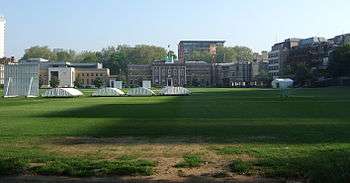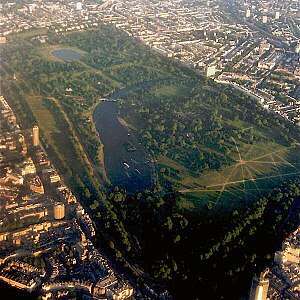Artillery Ground
The Artillery Ground in Finsbury is an open space originally set aside for archery and later known also as a cricket venue. Today it is used for military exercises, rugby and football matches. It belongs to the Honourable Artillery Company (HAC), whose headquarters, Armoury House, overlook the grounds.[1]
 | |
| Location | Finsbury, Islington |
|---|---|
| Home club | London Cricket Club |
| Establishment | by 1730 |
| Last used | 1778 (for first-class cricket) |
History
Origins
From 1498, about 11 acres (4.5 ha) of the 23-acre (9.3 ha) Bunhill Fields were set aside for the practice of archery and shooting. Today's 8-acre (3.2 ha) site was given to the Artillery Company in 1638.[2]
Cricket
In the 18th century sources, the Artillery Ground was said to lie 'between Chiswell Street and Bunhill Fields', the latter being a cemetery. It was referred to in contemporary reports as the 'old' Artillery Ground, but this may be because it was used frequently for other forms of sport or entertainment.[3] In a report dated 23 June 1722 in the London Journal, 'the entrance to it is by a handsome pair of iron gates to the south side next Chiswell-Street'.[4]
The earliest definite cricket match at the Artillery Ground took place on 31 August 1730 between London and Surrey. London won but no other details are known.[5] The ground quickly became London's first choice home venue with five matches recorded there in 1731: three against Dartford and two against Croydon.[6]
A report in 1732 states that the playing area was staked out and roped off. This practice is first reported at Kennington Common the previous year and cricket is believed to be the first sport to enclose its venues. The Artillery Ground was charging spectators a two pence admission fee by the early 1740s and it is believed that the fee was introduced in the 1730s, cricket also being the first sport to charge for admission.[7]
By the 1740s, the Artillery Ground had become the sport's feature venue and for about twenty years it had a social status that only Lord's Cricket Ground has subsequently equalled. Single wicket was especially popular in the 1740s and huge crowds gambling huge sums of money were attracted to the ground whenever these contests took place.[8]
The history of the ground is coloured by references to its keepers, or lessees. The first known reference is in The Craftsman dated Sat 26 February 1732 (Julian date) re Mr Christopher Jones, Master of the Artillery Ground, at the Pyed Horse public house in Chiswell Street.[9] The keepers were responsible for maintaining order at the ground. For example, Jones posted a notice in the newspapers that advertised a London v Kent match on 5 July 1733 as 'for one guinea each man with wickets to be pitched at one o'clock and the spectators to keep outside the line round the ground. If any persons get on the Walls [sic] they will be prosecuted as the Law directs; and the Company are desired to come through the Py'd Horse Yard, Chiswell Street'.[9] Obviously, by coming through the pub, many might well stop and buy a drink. Jones, as the landlord, would have no objection to that.[9]
The most charismatic keeper was George Smith who had frequent disputes with the HAC during his tenure. He also had money problems and there are surviving reports of his attempts to pay off his debts by raising the ground admission and then being forced to reduce it again.[9]
Before the creation of the Hambledon Club in the 1760s, the Artillery Ground was the featured venue of all London cricket. It eventually fell into disrepute because of uncontrolled gambling and ceased to be used for first-class cricket, the last known match taking place on 25 September 1778.[10]
Later history
On 15 September 1784 Vincenzo Lunardi, flew a balloon from the Artillery Ground, the first such flight in England.[11]
The area is now used for rugby and football in the winter and cricket in the summer by HAC teams including HAC RFC.[12] Notably, it hosted a rugby union match between Saracens and the USA national team on 9 November 2010, won 20–6 by Saracens.[13] It is also, as a source of revenue for the HAC, rented out for parties and events including the annual Cityrace 5km run through the City's streets.[14]
See also
- George Smith (cricketer, died 1761)
References
- From Lads to Lord's – 1638. Retrieved on 21 April 2009.
- Anthony Higmore (1804). The History of the Honourable Artillery Company of the City of London. p. 64.
- G. B. Buckley, Fresh Light on 18th Century Cricket, Cotterell, 1935.
- Maun, p. 26.
- H. T. Waghorn, Cricket Scores, Notes, etc. (1730-1773), Blackwood, 1899.
- Classification of cricket matches from 1697 to 1825. Retrieved on 21 April 2009.
- From Lads to Lord's – 1731. Retrieved on 21 April 2009.
- "History of Cricket". Princes Risborough Cricket Club. Retrieved 10 October 2018.
- G. B. Buckley, Fresh Light on Pre-Victorian Cricket, Cotterell, 1937.
- "The History of Cricket: 1776 – 1780". From Lads to Lord's. Archived from the original on 29 June 2011. Retrieved 10 October 2018.
- Rumens, Carol, 13 October 2008. "Poem of the Week: To a Louse", Guardian Books Blog, retrieved 5 August 2012.
- "HAC RFC". HAC RFC. Retrieved 18 November 2015.
- "Sarries beat USA in the City" (Press release). Saracens Ltd. 9 November 2010. Archived from the original on 15 June 2011. Retrieved 2010-11-09.
- "Race Information". Cityrace 2018. Archived from the original on 11 October 2018. Retrieved 10 October 2018.
Bibliography
- Birley, Derek (1999). A Social History of English Cricket. Aurum.
- Bowen, Rowland (1970). Cricket: A History of its Growth and Development. Eyre & Spottiswoode.
- Major, John (2007). More Than A Game. HarperCollins.
- Maun, Ian (2009). From Commons to Lord's, Volume One: 1700 to 1750. Roger Heavens. ISBN 978-1-900592-52-9.
- Underdown, David (2000). Start of Play. Allen Lane.
